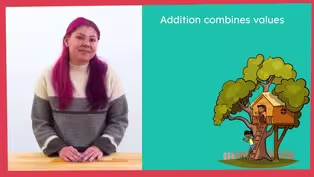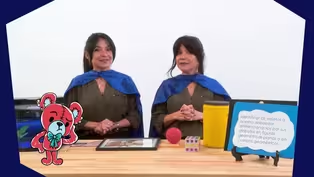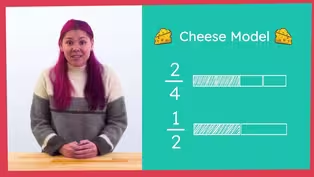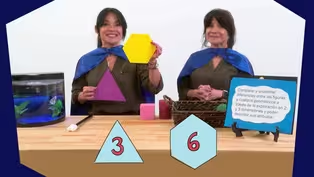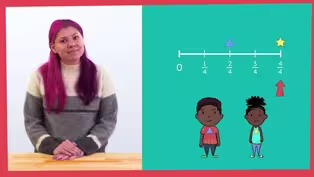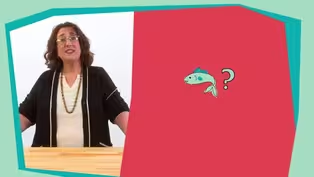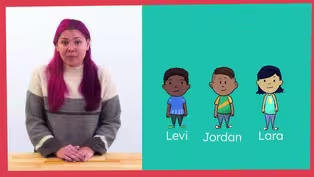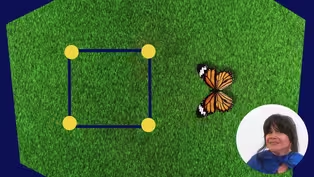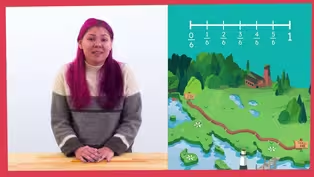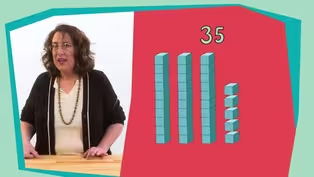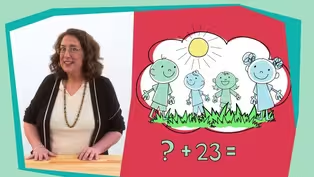
Episode 18 | Math Lessons
3/29/2021 | 28m 46sVideo has Closed Captions
Math lessons for early learners, led by NC teachers.
The first lesson (aimed at 3rd graders) helps students interpret patterns of multiplication. The second lesson (aimed at 1st-2nd graders) helps early learners recognize and combine groups of numbers. Classroom Connection is your At-Home Learning companion where children love to learn. All lessons are led by NC educators.
Problems playing video? | Closed Captioning Feedback
Problems playing video? | Closed Captioning Feedback
At-Home Learning Presents: Classroom Connection is a local public television program presented by PBS NC

Episode 18 | Math Lessons
3/29/2021 | 28m 46sVideo has Closed Captions
The first lesson (aimed at 3rd graders) helps students interpret patterns of multiplication. The second lesson (aimed at 1st-2nd graders) helps early learners recognize and combine groups of numbers. Classroom Connection is your At-Home Learning companion where children love to learn. All lessons are led by NC educators.
Problems playing video? | Closed Captioning Feedback
How to Watch At-Home Learning Presents: Classroom Connection
At-Home Learning Presents: Classroom Connection is available to stream on pbs.org and the free PBS App, available on iPhone, Apple TV, Android TV, Android smartphones, Amazon Fire TV, Amazon Fire Tablet, Roku, Samsung Smart TV, and Vizio.
Providing Support for PBS.org
Learn Moreabout PBS online sponsorshipMore from This Collection
Math lessons for early learners, led by NC teachers.
Video has Closed Captions
Math lessons for early learners, led by NC teachers. (28m 46s)
Video has Closed Captions
Math lessons for early learners, led by NC teachers. (28m 46s)
Video has Closed Captions
Math lessons for early learners, led by NC teachers. (28m 46s)
Video has Closed Captions
Math lessons for early learners, led by NC teachers. (28m 46s)
Video has Closed Captions
Math lessons for early learners, led by NC teachers. (28m 46s)
Video has Closed Captions
Math lessons for early learners, led by NC teachers. (28m 46s)
Video has Closed Captions
Math lessons for early learners, led by NC teachers. (28m 46s)
Video has Closed Captions
Math lessons for early learners, led by NC teachers. (28m 46s)
Video has Closed Captions
Math lessons for early learners, led by NC teachers. (28m 45s)
Video has Closed Captions
Math lessons for early learners, led by NC teachers. (28m 46s)
Video has Closed Captions
Math lessons for early learners, led by NC teachers. (28m 45s)
Video has Closed Captions
Math lessons for early learners, led by NC teachers. (28m 46s)
Providing Support for PBS.org
Learn Moreabout PBS online sponsorship[cheerful upbeat music] ♪ - This is wild.
Listen to this, from zero to 1000 the only number that has the letter a in it is 1000.
That's like a math fact and a reading fact.
Do you get extra credit for learning these amazing facts?
I'm just joking, but we're getting started with today's math lesson right now.
So don't go anywhere.
- Hello, friends, Diane here and I'm so happy to see you.
Today we're going to be talking about patterns we find in multiplication.
I've been thinking about some of the multiplication and division problems we've solved together and some of the strategies you've used, especially the skip counting strategy.
I wonder if we were to look at a hundreds chart, if we could find patterns and relationships between multiples of certain numbers.
Finding a pattern with multiples can help us better understand multiplication and help us learn our facts.
Do you wanna try?
Great.
Before we get started, let's review what we know about the words multiples and factors.
Let's use a Frayer Model to help us out.
Are you ready?
Let's get started.
To make our Frayer Model you will need, a piece of paper, a pen, pencil or a marker.
I'm going to get my supplies.
You go ahead and do the same.
[upbeat music] Now that we have our supplies, let's begin to make our Frayer Model.
Let's take a piece of paper and fold it in half, hamburger style.
Then we're going to fold it in half again to make four equal rectangles.
Then in the corner of our paper where all sides are folded we'll fold down a small triangle.
When you unfold your paper the folds should look like this.
[upbeat music] Did Yours look like mine?
Okay, great.
We're going to write the words, multiples and factors in the center diamonds, because these are the words we need to understand more about.
[upbeat music] Then in the upper left rectangle we're going to define each term.
So let's write the word definitions here.
[upbeat music] In the upper right triangle we're going to provide an example of multiples and factors.
So let's write examples here.
[upbeat music] Then in the lower left rectangle we'll provide a non-example or what multiples and factors are not.
So right non-examples here.
[upbeat music] And finally, in the lower right rectangle we'll draw a picture to help us visualize what multiples and factors are.
So let's write the word picture here to remind us of what we're supposed to do.
[upbeat music] Now we're going to define the words actually, we got two words, multiples and factors together.
So let's write the definitions in our upper left rectangle.
To begin a multiple is the result of multiplying another, a number by another number.
Factors are the numbers we can multiply together to get another number.
I'm going to give you some time to write these definitions in your Frayer Model.
[dramatic music] As we learn more about multiples and factors in today's lesson, you'll be able to add examples, non-examples and draw a picture to share your growing understanding of multiples and factors.
All right.
So, imagine you have a package of juice boxes, each package has 10 juice pouches in it, or one times ten equals ten.
So, how many would two boxes have?
Will you say it with me?
Two times ten equals twenty.
What about three boxes?
Great job.
3 times 10 equals 30.
So, what pattern did you see?
Great, each multiple has a zero in the ones place and the number in the tens place increases by one, they're all in the same column.
Using that pattern could you tell me how many juice pouches would be in six boxes?
Right, 6 times 10 equals 60.
Imagine counting by tens six times.
How about eight boxes?
Right, 80.
I'm counting by tens eight times.
How about 10 boxes.
Great, 10 times 10 equals 100.
I'm counting by tens 10 times.
Let's try multiples of a different factor.
Let's try multiples of fives on the 100 board.
Can you count with me?
5, 10, 15, 20, 25, 30, 35, 40, 45 50.
What do you notice about the multiples of fives and tens?
What was that?
Oh, tens and five share some multiples?
I noticed that every second multiple of five is also a multiple of 10.
That's really interesting.
I wonder why that happens.
Are the numbers 5 and 10 related to each other?
What do you think?
Not sure.
Let's look at a representation using these dots.
What do you notice about one group of five and one group of 10.
That's right, when you double five you get 10.
So two fives equals a ten.
Let's see how that looks on a hundreds chart.
5 10, 15, 20, 25, 30, 305, 40, 45, 50.
Every two fives equals a ten.
So we'll doubling the number of times I count by fives equal the same number of tens.
Let's try it, three times five, so I can count by fives three times 5, 10, 15.
If I count three more times that should be three times ten.
So 20, 25, 30.
Yeah, so what about four times five and four times ten?
I need to count by fives four times, 5, 10, 15, 20, then another four times to double it, 25, 30, 35, 40.
If fives and tens have that relationship what about other numbers that have the same relationship?
Do they follow the same pattern?
What if we try twos?
Let's count and highlight all of the multiples of twos?
2, 4, 6, 8, 10, 12, 14, 16, 18, 20.
What did you notice so far?
Yes, they follow a pattern.
They are all in the evens column.
Because they're even there is a two, a four, six, eight or zero in the ones place.
What number do I get if I double two?
What was that?
Right, four.
Two and four have the same relationship as five and ten.
So, should they share some of the same multiples?
Let's find out.
Let's use this pattern to fill in the hundreds chart with multiples of four.
We already have some of the multiples of twos highlighted.
So let's finish that up.
We know that doubling two will get us four, so every two multiples of two should be a multiple of four.
Let's try it; 4, 8, 12, 16, 20, 24.
What do you notice?
Yeah, the multiples of four are making a pattern.
Can you keep it going?
Nice.
Could you use this pattern to answer some multiplication questions?
What about five times four?
Maybe six times two?
What about eight times four?
seven times two?
Last one, nine times two?
Great job mathematicians.
Do you think there could be other patterns on the hundreds board with different numbers?
What about maybe three and six, or four and eight?
There are so many patterns to find with multiples.
We don't have time to look for them today but maybe you can explore them on your own.
Thanks for helping me today.
We learned that we can show patterns of multiples on a hundreds chart.
Thinking about these patterns and relationships between multiples helps us better understand multiplication and learn our facts.
Mathematicians, you did a great job today.
I hope to see you again soon, until next time, bye y'all.
[upbeat music] - The arts have made me the person I am today because I had been able to grow as a person using art to express myself.
How do you most like to express yourself?
Let's watch this awesome video about art and you can think of a new way to express the inner beauty.
[somber music] - There was this event at high school and these three black teenagers came up to me and they said, "Well, I've never seen a black artist before.
I've never seen a black woman artist."
And I was their first experience with that.
I think for a lot of people the concept of being an artist, being whatever, it's not that they always have examples of what makes sense to them, but when you have a visual example of something, especially something that looks like it relates to you, or it sounds like your circumstances, it just makes it that much easier for possibility to make sense, right?
When I was a kid my mom was really, really, very deliberate about making sure that me and my sister saw examples of black people doing wonderful things, because she wanted people that looked like us to set the bar for possibility for us.
- Oh, here we go.
- I think that for me, the best thing that I can do as an artist, as a black woman, as a black person, is to provide this example that says it's possible.
I didn't know I would be painting murals that were 200 feet long.
I didn't know, even if I knew I was gonna be an artist, it wasn't like part of my concept that that could be a thing.
When I get to the point where I'm making these monumental sculptures and I'm trying so, so, so hard to make that happen, it wasn't that it was in my concept that I would be that person, it's this from the soul, like knuckles white, like please understand that it's possible for you too.
The best thing I can do is live my life in a way that people can see themselves in me and understand that like their dreams are possible too.
And that's what I'm trying to do.
With that, like that for young girls, because I'm a black woman, because I'm a woman, because I have dreads, because I've got tattoos, 'cause I wear overalls if I want to.
Like, because of all these things and because I paint that in my pictures.
I want to make sure that at the end of my career I've created a possibility for all these other people so that when someone grows up and they're an artist and they say, "Well, I've done this thing."
Like I was the moment that I needed when I was a kid, and I saw Patricia Polacco painting that mural.
That I was the person for someone, for me playing on the sculpture at Haynes Point by JC R Johnson, I said, "I wanna make stuff like this.
I wanna be that for people."
Because it's so important for people to be able to say, "Okay, everyone in my world is telling me I can't, but I know that I can because Dare Coulter's doing it and she did it."
[upbeat music] That's it.
- The fastest recording raindrop was 18 miles per hour.
That would hurt if it fell on your head.
How do you record the speed of rain anyway?
Math helps us calculate speed and time, isn't that cool?
Get ready for our next math lesson 'cause it's starting now.
- Hi friends, my name is Dawn.
Splat and I are so happy to be here with you today.
We are going to have some fun with subitizing.
Remember that subitizing is quickly seeing how many things such as dots.
I am so excited to do this with you today and so is Splat.
We are going to use a 10 frame today to talk about numbers that are 10 plus some more.
Remember, when we break apart numbers that is called decomposing.
Decomposing numbers helps us to combine smaller groups of dots easier to make a total.
Your job is to say or show how many dots you see with each picture that flashes on the screen.
Then you get to explain how your brain saw the dots and how that helped you to know how many total dots were shown.
You can tell this to a trusted adult or stuffed animal, or even to Splat.
This is going to be so much fun.
Before we get started, you can find a stuffed animal or an adult to talk to during our subitizing.
You can also go find some beans or pasta to show you the different numbers you see on the screen.
And finally, you might want to get some paper and pencil or a notebook to write in to explain what you'll learn today.
We'll wait for you to get everything.
[upbeat music] Wow, subitizing, that's an interesting word.
Let's use a Frayer Model to think more about that.
Let's take a piece of paper and we're going to fold it in half hamburger style and then fold it in half again to make four equally sized rectangles.
Then in the corner of our paper where all sides are folded, we'll fold down a small triangle.
When you unfold your paper the fold should look like this.
Does yours look like mine?
Okay, great.
We're going to write subitizing in the center diamond because this is the word we need to understand more about.
[upbeat music] Then in the upper left rectangle we're going to define or write what this word means.
So let's write definition here.
In the upper right rectangle we're going to provide an example of subitizing.
So let's right example here.
Then in the lower left rectangle we'll provide a non-example or what subitizing is not, so write non-example here, and finally in the lower right rectangle we'll draw a picture to help us visualize what subitizing is.
So let's write picture here to remind us of what we're supposed to do.
Now we're going to define subitizing together.
So Splat and I are playing a game with die.
When we roll the die we wouldn't count the number of dots we see in order to move, we would subitize to know how many spaces we should move.
So subitizing is when we are able to see small quantities or amounts without having to count them.
Now that we've defined subitizing, Splat and I are going to give you some time to write this definition in your Frayer Model where it says definition.
[dramatic music] Okay, as we learn more about subitizing in today's lesson you will be able to add examples, non-examples and draw a picture to share your growing understanding of subitizing.
Okay, are we all ready?
Splat's ready?
Let's go, watch the screen.
[upbeat music] Wow, did you see that Splat?
That was super quick.
Tell an adult or even a stuffed animal how many dots you saw?
Yes, Splat and I saw 16 also.
How did you see those 16 dots?
Will you whisper to Splat how your eyes saw the dots?
[guitar music] Splat said he saw one group of 10 dots and six dots leftover and he knows that 10 plus 6 equals 16.
What If I took one dot away from the 10 frame?
How many dots would I have then?
Whisper to yourself, how many dots I'd have If I took one dot away?
Did you say 15?
That's right.
One less than 16 is 15.
It would look like this.
Great job thinking about the 10 frame.
I think we're ready for another one.
Watch the screen.
How?
Splat did you see that?
It was super fast again.
Friends, can you tell Splat how many dots you saw?
[upbeat music] 17, that's right.
What great thinking?
Now, will you tell Splat how you saw those dots?
[upbeat music] Friends, I want to share with you what Splat and I saw.
I saw a 10 frame all filled up, so I knew I had 10.
Then I saw four dots and three dots and I know that 4 plus 3 equals 7.
Then I combined one 10 with 7 leftover to make 17 because 10 plus 7 equals 17.
Are you ready to try some more?
Splat is.
Watch the screen for a new image.
Whoa, did you see that?
How many dots were there?
Tell an adult or stuffed animal how many dots you saw?
[upbeat music] Did you say that you saw 18 dots?
Splat agrees.
How did you know they were 18 dots?
Tell Splat how your brain figured that out.
[upbeat music] Splat heard someone say that they broke apart the extra 10 dots and slid 2 of them into the 10 frame.
Then they had 8 left over and they knew that one 10 and 8 ones is equal to 18.
That's right Splat.
Okay friends, Splat and I have time for one more image, are you ready?
Watch the screen.
Wow, Splat was so surprised.
Did you see that?
There were two 10 frames.
Tell Splat how many dots you saw and how your eyes saw those dots.
You could even make it with your beans or pasta.
He saw 20 dots too, and he saw one group of 10 and another group of 10.
And he knows that 10 plus 10 equals 20.
Did you see that too?
Have one more question, what is one less than 20?
Whisper to yourself, what our total would be if we took away one dot.
[upbeat music] Splat and I heard you say 19, that's right.
If we took away one dot we would have 19, because 20 minus 1 equals 19.
[upbeat music] Friends, Splat and I had so much fun here with you today.
We'd love subitizing with you and decomposing numbers.
Decomposing is great because we can break apart numbers and add two other numbers to help us make 10.
Splat and I would love to hear you say what you learned in your own words.
I have this sentence starters and I'm hoping you can finish these sentences with me.
They say, today in math I learned and I can.
So I might say, today in math I learned how to use a 10 frame to help me add numbers up to 20.
I can decompose numbers into smaller numbers to help me get to 10 and then add on to find my total.
Now, it's your turn.
Read this with me and finish it by telling an adult or stuffed animal: Today in math I learned... [upbeat music] That's awesome.
Now let's read our next sentence and you can finish it.
I can... [upbeat music] You are doing a great job talking about your math learning.
[upbeat music] Next, you could also write this on paper or in your notebook and start a math journal.
Let's look at our Frayer Model again.
Let's think about our examples and non-examples together.
For the example square we could say, an example might be dice.
Since when we look at the dots on dice we don't usually count them, we just know how many dots we see.
A non-example or something that is not subitizing might be counting like one, two, three, four, five, because subitizing is seeing how many without counting.
[upbeat music] Now that we've done most of the Frayer Model together, I challenge you to add a picture to show your understanding of subitizing.
I also challenge you to add more examples and non-examples on the chart.
This will help you show your learning from today's lesson.
You can share your learning with a friend like Splat or a trusted adult.
[upbeat music] Splat and I must go now, but you did a lot of hard thinking about numbers and decomposing, and how we then add on to new numbers.
Great work.
- You can often tell what a bird does for a living simply by looking at its beak.
Take for instance the North Carolina State bird, the Northern Cardinal, take a look at that beak, it's short, it's stout, it's very powerful, all about crushing seeds, or here I've got the skull from a bald eagle.
Look at that sharply hooked beak, it's absolutely perfect for tearing the flesh from other living creatures.
And over here we've got the woodpecker.
Now, everybody knows what a woodpecker does with its beak, it uses it like a chisel, chiseling in dead woods searching for insect larvae, like a beetle grub for instance.
Now the beetle grub doesn't cooperate, it doesn't wanna get eaten.
So it tries to push itself further back into the hole and if the woodpecker is unable to reach the beetle grub with its beak, it pulls out a secret weapon.
And that secret weapon is the woodpecker's tongue.
It is shaped just like a harpoon, like a spear with hooks on it.
And you've got to really see this up close to appreciate it.
Now here, I'm pulling down the tongue from this red belly woodpecker, and as you can clearly see there are hooks there, and look which direction they're going, they're going up and to the back, up and to the back.
So when it spears the beetle grub, there's no way it's gonna wriggle off.
It's like a fish on a fish hook, it just pulls it right out.
Absolutely amazing.
So the next time you see birds in your backyard, take a look at the beak and see if you can determine what they do for a living.
So from the North Carolina Museum of Natural Sciences, thank you for observing a moment of science.
- Well, it's time to go, but I can't wait to see you next time.
Hope you learned a lot today and every day.
Wishing you peace, love and lots of learning.
[cheerful upbeat music] ♪


- Home and How To

Hit the road in a classic car for a tour through Great Britain with two antiques experts.












Support for PBS provided by:
At-Home Learning Presents: Classroom Connection is a local public television program presented by PBS NC
